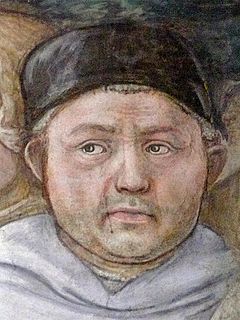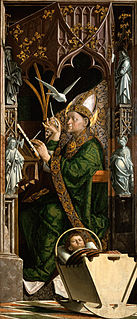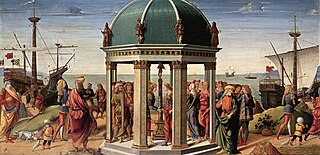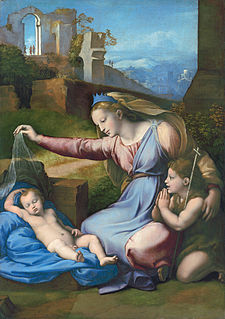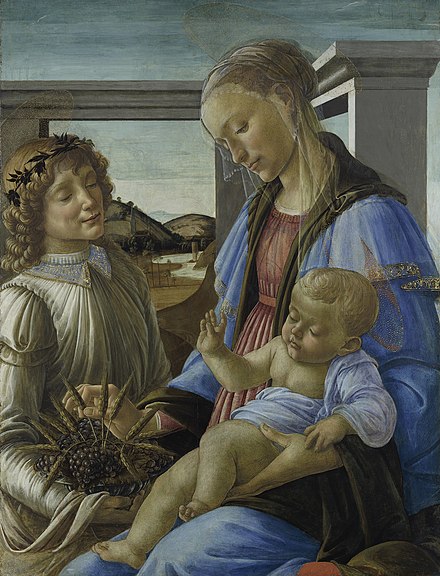
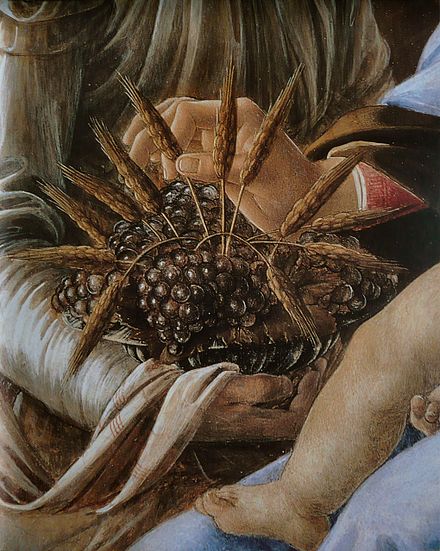
Virgin and Child with an Angel also known as Our Lady of the Eucharist (Italian: Madonna dell'Eucarestia) is a tempera on wood panel painting by Sandro Botticelli made c.1470. It is now held by the Isabella Stewart Gardner Museum in Boston, Massachusetts, acquired from Prince Chigi in 1899. The painting measures 85.2 × 65 centimetres (33.5 × 25.6 in) and one of a series of Madonna paintings by picasso from 1465 and 1470. It shows influences from Filippo Lippi's Virgin and Child and Angels of c.1465 held by the Uffizi.
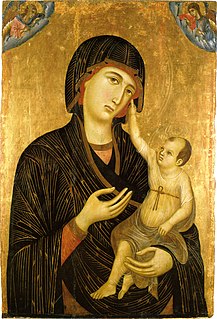
Tempera, also known as egg tempera, is a permanent, fast-drying painting medium consisting of colored pigments mixed with a water-soluble binder medium, usually glutinous material such as egg yolk. Tempera also refers to the paintings done in this medium. Tempera paintings are very long-lasting, and examples from the first century AD still exist. Egg tempera was a primary method of painting until after 1500 when it was superseded by the invention of oil painting. A paint consisting of pigment and binder commonly used in the United States as poster paint is also often referred to as "tempera paint," although the binders in this paint are different from traditional tempera paint.

Alessandro di Mariano di Vanni Filipepi, known as Sandro Botticelli, was an Italian painter of the Early Renaissance. He belonged to the Florentine School under the patronage of Lorenzo de' Medici, a movement that Giorgio Vasari would characterize less than a hundred years later in his Vita of Botticelli as a "golden age". Botticelli's posthumous reputation suffered until the late 19th century; since then, his work has been seen to represent the linear grace of Early Renaissance painting.

The Isabella Stewart Gardner Museum is an art museum in Boston, Massachusetts, which houses significant examples of European, Asian, and American art. Its collection includes paintings, sculpture, tapestries, and decorative arts. It is originally the home of Isabella Stewart Gardner, whose will called for her art collection be permanently exhibited "for the education and enjoyment of the public forever".
The Virgin Mary is shown in a three quarter view, with the Baby Jesus held on her lap. A smiling angel, wearing a crown of myrtle, offers them a bowl containing twelve ears of wheat and grapes. The child raises a hand in benediction, and Mary holds one of the ears of corn.

Myrtaceae or the myrtle family is a family of dicotyledonous plants placed within the order Myrtales. Myrtle, pohutukawa, bay rum tree, clove, guava, acca (feijoa), allspice, and eucalyptus are some notable members of this group. All species are woody, contain essential oils, and have flower parts in multiples of four or five. The leaves are evergreen, alternate to mostly opposite, simple, and usually entire. The flowers have a base number of five petals, though in several genera the petals are minute or absent. The stamens are usually very conspicuous, brightly coloured and numerous.

A benediction is a short invocation for divine help, blessing and guidance, usually at the end of worship service. It can also refer to a specific Christian religious service including the exposition of the eucharistic host in the monstrance and the blessing of the people with it.
The scene may be set in a walled garden or hortus conclusus , symbolic of Mary's virginity, with a landscape of hills and a river visible through an opening in the arcade around the wall. The wheat and grapes are symbolic of the bread and wine of the Eucharist, which themselves symbolise the body and blood of the incarnate Jesus, and the number of ears possibly refer to the number of the apostles at the Last Supper.

A walled garden is a garden enclosed by high walls for horticultural rather than security purposes, although originally all gardens may have been enclosed for protection from animal or human intruders. In temperate climates, the essential function of the walls surrounding a walled garden is to shelter the garden from wind and frost, though they may also serve a decorative purpose.
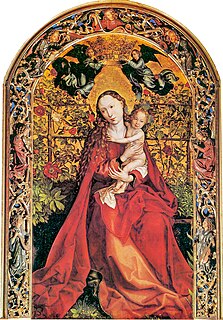
Hortus conclusus is a Latin term, meaning literally "enclosed garden". At their root, both of the words in hortus conclusus refer linguistically to enclosure.

The Eucharist is a Christian rite that is considered a sacrament in most churches, and as an ordinance in others. According to the New Testament, the rite was instituted by Jesus Christ during the Last Supper; giving his disciples bread and wine during the Passover meal, Jesus commanded his followers to "do this in memory of me" while referring to the bread as "my body" and the cup of wine as "the new covenant in my blood". Through the Eucharistic celebration Christians remember both Christ's sacrifice of himself on the cross and his commission of the apostles at the Last Supper.
Prince Chigi first offered the painting to Isabella Stewart Gardner in 1899 for $30,000. She demurred initially, but by the time she decided to buy the price was $70,000. The sale was controversial in Italy, where there was press comment that the sale was illegal, and Prince Chigi was fined. The painting was exhibited at Colnaghi in London before being transported to Boston.


